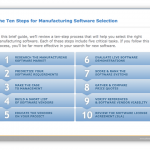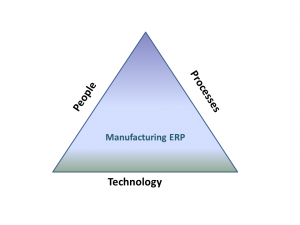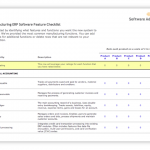Finding the right Small Business ERP for your company
Small Business ERP is a unique category of enterprise software. It typically needs to have all the functionality of large corporate ERP software, but it needs to have as few clicks and screens as possible to ensure that the users are not overburdened with a lot of time spent entering data. The size of the business does not necessarily change the functionality required in the software. Rather, the small company often has a need for higher efficiency since they cannot afford the manpower to maintain the system.
When you look at ERP software, there are three tiers of applications. Tier 1 is large multi-national software solutions, such as Oracle, SAP, and JD Edwards. Tier 2 is the mid-market level. These applications are suitable to businesses in the range of 50M to 250M. This is the sweet spot of the market. Like any bell curve, the mid-market has both the most customers, as well as the most product offerings. The last tier is the Tier 3 offerings which is the small business ERP category. These are systems suitable for 1 person startups to about the $50M level, although some of these products become inefficient if they have more than 20 users on the system. So while they claim to be Small Business ERP offerings, they are for the smallest of companies.

Things to look for in Small Business ERP
When evaluating small business ERP solutions, it is important that you properly screen the potential software candidates to ensure you get a software that fits your business. If you don’t you will run into many different issues. Here are some tips:
1. Make sure that the small business ERP software you are looking at fits into your niche.
2. Make sure that the data entry is simple and efficient
3. Make sure that the database platform can be managed by you or your staff
4. Look at the support offerings of the small business ERP provider to ensure that it is tailored to your needs
5. Determine that the small business ERP reseller provides enough training to properly get your staff up and running
Let’s discuss these points. First you need to make sure that the software you are looking at fits within the business model or industry that you work within. A retail store should not use a software designed for distributor. See what other customers that the software provider has worked with in the past and ask for specific examples of companies in your industry.
You need to make sure that the users do not become slaves to the system. Make sure that the data entry screens are simple, efficient and do not require a lot of bouncing around to other screens to input simple things such as invoices or purchase orders.
The heart of the system is the database. You need to make sure that the database does not require a full time system admin to maintain it. It should be designed to be self maintaining and easily managed. Learn a little bit of the technical requirements from the Small Business ERP solution provider. You do not want to be in the situation where you need to bring in a specialized database administrator if later something goes wrong.
Small Business ERP should have support designed for you the small business owner. You should easily be able to call in and immediately speak to a rep for support. You don’t want to have to wait for days to get answers. Be careful of small systems with small support staffs. Especially be wary where the system is developed and maintained by one or two people. Yes, they are also a small business, but it will be a big problem when they are not available to assist you.
Lastly, you and your staff need to have enough training to properly operate the application. Do not skimp on this point. You need more training than you think. In fact, it would be good to plan on training to go live and at least one other training session a month after go-live to answer any questions and resolve any problems from a lack of knowledge. You won’t become experts on the system in a day, so plan on future training sessions.
The future of Small Business ERP
The future of Small Business ERP seems to be one of two paths. There are those systems that will continue to be operating on a small network of computers and do quite well on them, such as Quickbooks or DBA Software. The other path is that of small business ERP companies such as Netsuite, who are leading the charge to bring small business ERP to the cloud. This means that you will have access to the application through a browser and no installed software will exist on your site. You are licensing access to a system that stores your data remotely and operates via an internet connection.
People often are concerned with this model as your data lives somewhere else. The fact of the matter is it is probably safer there than on a computer sitting in your back room. The data center security policies and the high-levels of authentication that are enforced by cloud computing providers truly lock down your data and its accessibility. Whereas your server in your back room is often open to anyone who happens to wonder by. This seems to be riskier. Nonetheless, whichever path you choose, you can be assured that the small business ERP industry is continuing to grow and develop.
Instantly Download our Free Ten Steps Guide to Selecting the Right Accounting Software

Download our Free Ten Steps Guide to Selecting the Right Accounting Software Now!
Small Business ERP


